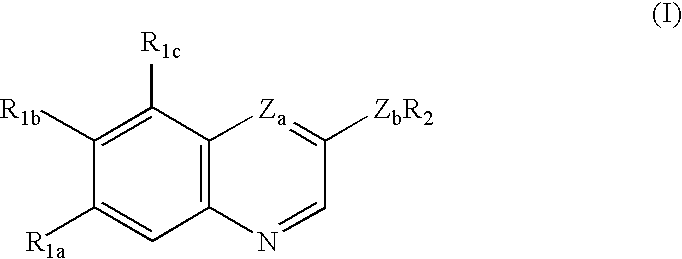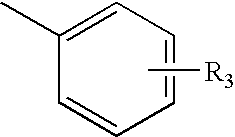Quinoline and quinoxaline compounds which inhibit platelet-derived growth factor and/or p56lck tyrosine kinases
a technology of quinoline and quinoxaline compounds, which is applied in the direction of biocide, drug compositions, cardiovascular disorders, etc., can solve the problems of unfavorable inhibition of insulin, agents from these classes of compounds,
- Summary
- Abstract
- Description
- Claims
- Application Information
AI Technical Summary
Benefits of technology
Problems solved by technology
Method used
Image
Examples
example 8
3-Cyclohexyloxy-6,7-dimethoxyquinoline
To a THF solution (30 mL) at 0° C. is added 3-hydroxy-6,7-dimethoxyquinoline (0.237 g, 1.15 mmol), cyclohexanol (0.347 g, 3.46 mmol), Ph3P (0.908 g, 3.46 mmol). Diethylazodicarboxylate is added portionwise until the solution retained a deep red color (0.663 g, 3.81 mmol). After 4 hours the solution is concentrated and the residue chromatographed (50% EtOAc in hexanes). The product is recrystallized from isopropanol / hexanes as the HCl salt as a white solid (m.p. 229-232° C., dec.).
example 9
2-Anilino-6-quinoxalinol
By the method of Feutrill, G. I., Mirrington, R. N. Tet. Lett. 1970, 1327; the aryl methyl ether is converted to the phenol derivative. To 2-anilino-6-methoxy-quinoxaline (0.27 g, 1.07 mmol) under argon in DMF is added the sodium salt of ethanethiol (0.19 g, 2 mmol). The reaction mixture is heated to 110° C. overnight. The mixture is concentrated and partitioned between EtOAc and H2O / 5% tartaric acid such that the pH of the aqueous layer is approximately 4. The organic layer is washed with H2O (4×), then with 2.5% NaOH (4×). The basic layers combined, washed with EtOAc (2×), re-acidified with 5% tartaric acid, and washed with multiple portions of EtOAc. The organic layers are combined, washed with brine, dried (Na2SO4), and concentrated. The resulting solid is chromatographed (50% EtOAc / hexanes). An analytical sample is obtained by triturating the product with Et2O to provide a yellow powder (m.p. 211-213° C.). Anal. Calcd. for C14H11N3O: C, 70.88; H, 4.67; N...
example 10
Phenyl-[6-(tetrahydrofuran-3-(R)-yl-oxy)quinoxalin-2-yl]amine
To a THF solution at 0° C. under argon is added 2-anilino-6-quinoxalinol (0.23 g, 0.97 mmol), (S)-(+)-3-hydroxytetrahydrofuran (0.086 mL, 1.3 mmol), and triphenylphosphine (0.31 g, 1.2 mmol). DEAD (0.18 mL, 1.2 mmol) is added portionwise. The reaction is allowed to warm to room temperature and stirred for 1.5 hours. The mixture is concentrated and partitioned between EtOAc and H2O. The organic layer is washed with H2O, brine, dried (MgSO4), and concentrated. The resulting yellow oil is chromatographed (50% EtOAc / hexanes) and taken up in Et2O / IPA (isopropanol). HCl / Et2O solution is added dropwise and the resulting red-orange powder is dried in vacuo. The powder is free-based by stirring in MeOH with washed (3×H2O, 5×MeOH) basic ion exchange resin. The mixture is stirred 30 minutes, filtered, concentrated, and recrystallized from EtOAc / hexanes to provide, in two crops, the product (m.p. 173-175° C.). Anal. Calcd. for C18H17N...
PUM
| Property | Measurement | Unit |
|---|---|---|
| Composition | aaaaa | aaaaa |
| Mechanical properties | aaaaa | aaaaa |
| Hydrophilicity | aaaaa | aaaaa |
Abstract
Description
Claims
Application Information
 Login to View More
Login to View More - R&D
- Intellectual Property
- Life Sciences
- Materials
- Tech Scout
- Unparalleled Data Quality
- Higher Quality Content
- 60% Fewer Hallucinations
Browse by: Latest US Patents, China's latest patents, Technical Efficacy Thesaurus, Application Domain, Technology Topic, Popular Technical Reports.
© 2025 PatSnap. All rights reserved.Legal|Privacy policy|Modern Slavery Act Transparency Statement|Sitemap|About US| Contact US: help@patsnap.com



